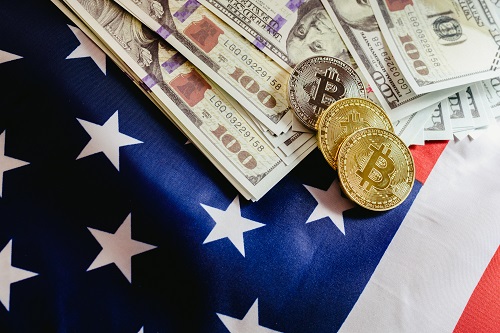- The US dollar is the global reserve currency, meaning it is a key influence on all risk assets
- Bitcoin has seen its negative correlation with the dollar pick up since the transition to a tight monetary regime, meaning it tends to strengthen when the dollar falls
- This inverse relationship has softened in recent weeks, as Bitcoin has failed to capitalise on dollar weakness arising from lower inflation in the US
- If history is to be followed and the correlation returns, Bitcoin could be in a place to advance
The status of the US dollar as the world’s reserve currency means it exhibits an enormous influence on risk assets not only in the US, but across the financial world.
Bitcoin is no exception. We have seen an inverse relationship between the two assets play out over the last few years, meaning that as the dollar weakens, Bitcoin tends to strengthen, and vice-versa.
This is for a couple of reasons. Firstly, Bitcoin is commonly quoted in USD due to, as mentioned above, the dollar being the global reserve currency. Therefore, it is simple math that when the denominator weakens (dollar), the ratio goes up, all else equal.
However, the effects run deeper. Across international trade, debt and non-bank borrowing, the dollar reigns supreme. Firms issuing debt in foreign currency do so via the dollar an estimated 70% of the time (the euro is next with approximately 20%). Again, this is due to its status as the global reserve currency (we see the same in sovereign debt markets). As the dollar weakens, the cost of servicing this debt falls, greasing the wheels of global liquidity. Hence, risk assets tend to appreciate as the dollar falls, albeit a generalisation.
For Bitcoin, we saw this in effect in 2022, as the dollar surged to a twenty-year high while Bitcoin was ravaged in line with risk assets across the market. Yet in the last month, the correlation has been fading and heading towards zero (i.e. no relationship at all).
The above chart shows that this has happened a few times before in the last six months, only for the correlation to soon return (i.e. dip back down towards -1). The first major deviation came in March, when the regional bank crisis was triggered amid the sudden collapse of Silicon Valley Bank, sparking mass volatility in the market, with Bitcoin gaining nicely in the aftermath. More recently, the deviation seem to have been caused by the crypto-specific episodes featuring the SEC’s lawsuits against Binance and Coinbase, and the spot ETF applications from a slew of large asset managers.
In the last week, the dollar has weakened further, continuing its steep downward trend. Its fall of nearly 2.5% is its worst drop since November, when softer-than-expectation inflation readings landed, fuelling speculation that the Federal Reserve would pare back on interest rate rises sooner than previously anticipated. Higher interest rates propel dollar strength, as capital is attracted to the dollar to exploit the higher yield on offer.
Ten days ago, inflation landed at 3%, again softer than expected and causing a repeat of November’s episode: yet more dollar decline as the market positions itself for a potential end to the rate hiking regime. There is also the case of the dollar strengthening during times of macro uncertainty because, as the reserve currency, it is the safest asset on record. With correlations going to one in a crisis, there tends to be a significant strengthening of the dollar when fear increases.
This is part of the reason for the dollar’s relentless advance in the first three quarters of last year, while the subsequent easing this year has seen the opposite. The below chart shows this relationship over the last half-century, with periods of recession (grey on the chart) typically resulting in gains for the greenback.
Looking forward, one can imagine a scenario where the dollar continues to head lower. Inflation in the US is far lower than most other countries; eurozone inflation is at 5.5%, while the UK is at 7.9%, to name a couple. The Fed should have a greater ability to ease off the rate hikes if that divergence is maintained and inflation in the US continues to fall.
For Bitcoin, should its inverse relationship with the dollar return, this could mean it may in a position to take advantage. It should be noted, however, that crypto-specific risk is high, which can overshadow any dollar effects easily. Not to mention the macro climate remains uncertain, even if things are brightening up. But history tells us that a weakening dollar is a boon for Bitcoin, and the past nine months have been no exception to this rule.














